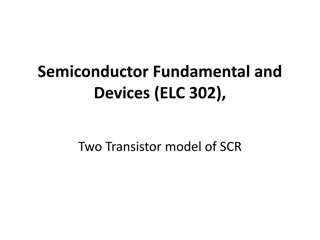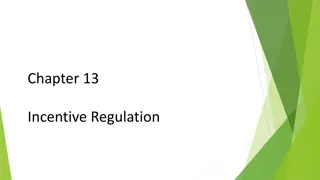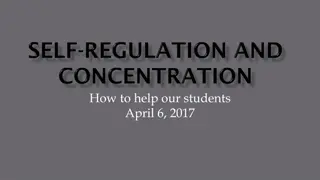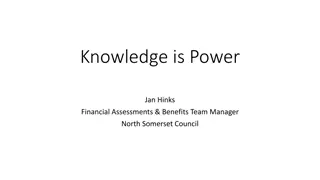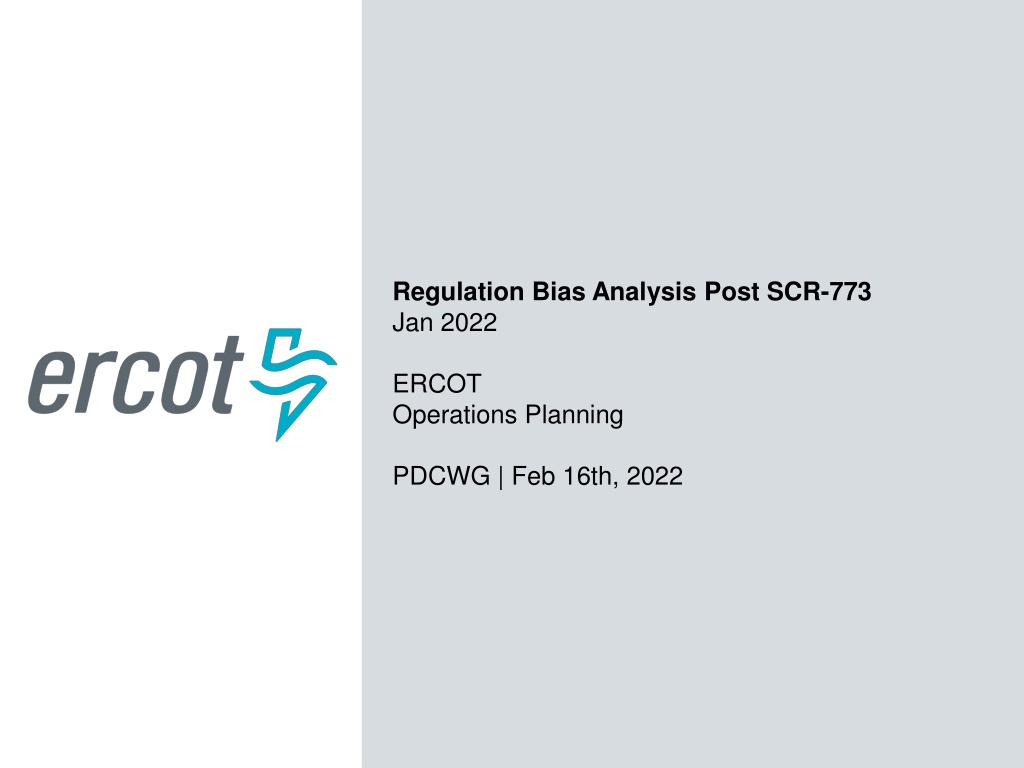
ERCOT Operations Planning Metrics and Analysis Insights
Gain insights into ERCOT operations planning through a detailed analysis of regulation bias post SCR-773 in January 2022. Explore current parameters, projected wind and solar ramp rates, and key performance metrics for regulation deployment.
Download Presentation

Please find below an Image/Link to download the presentation.
The content on the website is provided AS IS for your information and personal use only. It may not be sold, licensed, or shared on other websites without obtaining consent from the author. Download presentation by click this link. If you encounter any issues during the download, it is possible that the publisher has removed the file from their server.
E N D
Presentation Transcript
Regulation Bias Analysis Post SCR-773 Jan 2022 ERCOT Operations Planning PDCWG | Feb 16th, 2022
Discussion Points 1. Current GTBD Parameters & References 2. Metric to measure Regulation bias and performance 3. Regulation Deployed comparison for last three months. 4. Total Regulation (net) Deployed Comparison 5. Regulation Deployed 15-minute interval comparison by each hour for 2018, 2019, and 2020 months 6. Regulation Exhaustion Rate 7. Regulation bias for consecutive 5-min SCED intervals 8. Time Error & Contributing Factors 9. Summary
Current GTBD Parameters 3 PUBLIC
Projected Wind Ramp Rate MAE 4 PUBLIC
Projected Wind Ramp Rate Error 5 PUBLIC
Projected Solar Ramp Rate MAE 6 PUBLIC
Projected Solar Ramp Rate Error 7 PUBLIC
References Hours Jan-20 Jan-21 Jan-22 8, 9, 10, 18, 19, 20 8, 9, 18, 19, 20, 21 7, 8, 9, 19, 20, 21 Peak Off-Peak Up-Ramp Down-Ramp 1, 2, 3, 4, 5, 24 1, 2, 3, 4, 5, 24 1, 2, 3, 4, 15, 16 4, 5, 6, 7, 17, 18 5, 6, 7, 8, 17, 18 5, 6, 7, 8, 17, 18 11, 20, 21, 22, 23, 24 11, 20, 21, 22, 23, 24 9, 11, 12, 22, 23, 24 8 PUBLIC
Metrics to Measure SCR-773 Performance 1. Trend and monitor the regulation deployed by hour. 2. Set target of 50 MW for total regulation deployed by hour for peak hours. 3. Set target of 85% for the number of intervals where regulation deployment was both up and down for peak hours. 4. Track the Regulation exhaustion rate for all hours (not to exceed 5%). 5. Using a 50MW filter, target 15 occurrences or less per month for regulation bias of six or more consecutive 5 minute intervals for peak hours.
TOTAL REGULATION DEPLOYED COMPARISON Total regulation deployed for the last three months. PUBLIC
METRIC 1: REGULATION DEPLOYED COMPARISONS Trend and monitor the regulation deployed by hour. PUBLIC
Regulation Deployed Comparison Regulation Performance Jan-20 47 68 -21 59 70 -11 37 61 -24 79 45 34 31 84 -53 Jan-21 52 79 -27 69 74 -5 34 70 -36 101 49 52 30 92 -63 Jan-22 53 76 -23 49 84 -35 40 73 -33 96 51 45 36 93 -57 REGUP All REGDN TOTAL REGUP Peak REGDN TOTAL REGUP Off-Peak REGDN TOTAL REGUP Up-Ramp REGDN TOTAL REGUP Down-Ramp REGDN TOTAL 13 PUBLIC
Regulation Deployed Comparison 14 PUBLIC
Regulation Deployed Comparison 15 PUBLIC
METRIC 2: TOTAL REGULATION DEPLOYED COMPARISONS Set target of 50MW for total regulation deployed by hour for peak hours. PUBLIC
Total Regulation Deployed Comparison 17 PUBLIC
METRIC 3: 15-MIN INTERVALS WHERE BOTH REGUP/REGDN WERE DEPLOYED Set target of 85% for the number of intervals where regulation deployment was both up and down. PUBLIC
Zero Crossing Regulation Zero-Crossing Regulation HE 1 2 3 4 5 6 7 8 9 10 11 12 13 14 15 16 17 18 19 20 21 22 23 24 Jan-20 88.71% 81.45% 85.48% 91.94% 91.94% 89.52% 91.13% 83.87% 84.68% 83.06% 80.65% 87.90% 86.29% 83.87% 87.90% 88.71% 84.68% 73.39% 72.58% 83.06% 81.45% 86.29% 90.32% 91.13% Jan-21 92.74% 82.26% 80.65% 91.13% 89.52% 90.32% 92.74% 79.03% 69.35% 76.61% 79.84% 87.90% 91.94% 88.71% 89.52% 91.94% 76.61% 66.94% 87.10% 87.10% 87.90% 89.52% 84.68% 88.71% Jan-22 88.71% 82.26% 83.87% 87.90% 85.48% 85.48% 85.48% 87.90% 65.32% 87.10% 82.26% 78.23% 79.84% 81.45% 88.71% 79.84% 72.58% 54.84% 60.48% 86.29% 89.52% 86.29% 87.10% 89.52% 19 PUBLIC
Zero Crossing Regulation Jan-20 85.42% 80.11% 88.44% 87.10% 85.48% Jan-21 85.11% 79.57% 87.50% 82.53% 86.29% Jan-22 81.52% 79.17% 85.22% 78.63% 81.45% All Peak Off-Peak Up-Ramp Down-Ramp 20 PUBLIC
METRIC 4: REGULATION EXHAUSTION RATE Track the regulation exhaustion rate for all hours (not to exceed 5%.) PUBLIC
Regulation Exhaustion Rate Regulation-Up Jan-20 Jan-21 Jan-22 All Hours Average 2.24% 1.04% 1.78% 22 PUBLIC
Regulation Exhaustion Rate Regulation-Down Jan-20 Jan-21 Jan-22 All Hours Average 4.54% 2.90% 4.20% 23 PUBLIC
METRIC 5: STATSON REGUP BIASFOR CONSECUTIVE 5-MIN INTERVALS Using a 50MW filter, target 15 occurrences or less per month for regulation bias of six or more consecutive 5- minute intervals for peak hours. PUBLIC
Regulation Bias for Consecutive SCED Intervals Regulation-Up Jan-20 55 Jan-21 53 Jan-22 65 All Peak 30 21 11 25 PUBLIC
Regulation Bias for Consecutive SCED Intervals Regulation-Down Jan-20 99 30 Jan-21 113 27 Jan-22 131 40 All Peak 26 PUBLIC
TIME ERRORAND CONTRIBUTING FACTORS Accumulated Time Error, Load and Wind Ramp, PWRR Error, Start-Up/Shut-Down Hours, STLF Error, and Expected Generation Deviation. PUBLIC
Time Error Accumulation 28 PUBLIC
Load Profile 29 PUBLIC
Net Load Profile 30 PUBLIC
Load Ramp 31 PUBLIC
Wind Profile 32 PUBLIC
Start-Up & Shut-Down Hours 33 PUBLIC
Short-Term Load Forecast Error 34 PUBLIC
STLF Error Chart 35 PUBLIC
Expected Generation Deviation Expected Generation Deviation Jan-20 -18.90 Jan-21 -22.42 Jan-22 -20.89 All Hours Average 36 PUBLIC
Expected Generation Deviation 37 PUBLIC
Expected Generation Deviation 38 PUBLIC
QUESTIONS? Thank you! PUBLIC



